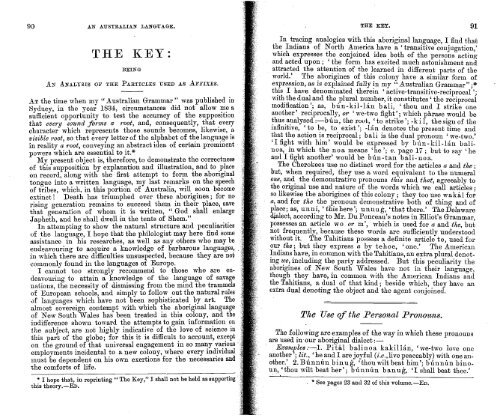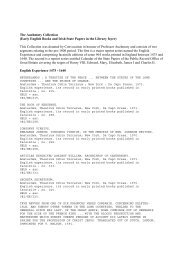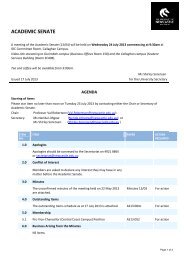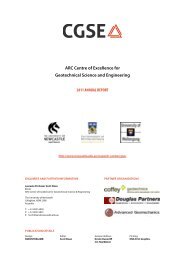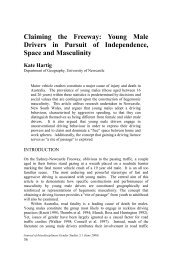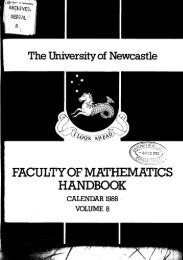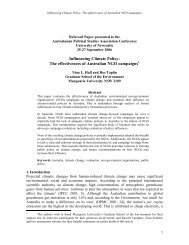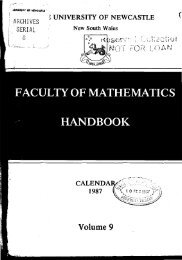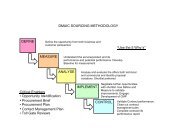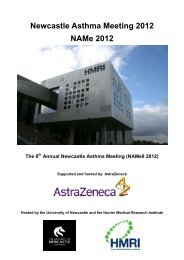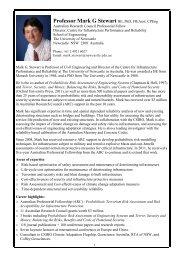n - University of Newcastle
n - University of Newcastle
n - University of Newcastle
Create successful ePaper yourself
Turn your PDF publications into a flip-book with our unique Google optimized e-Paper software.
AX AUSTRALIA?? LANGUAGE.<br />
THE IKEY:<br />
BEING<br />
Ax Aa~a~rsrs OF THE PARTICLES ESED as AFFIXES.<br />
AT the time when my '' L4ustraliall Grammar " mas published in<br />
Sydney, in the year 1534, circumstances did not allow me a<br />
sufficient opportunity to test the accuracy <strong>of</strong> the supposition<br />
that every sound fotwzs n ~oot, and, consequently, that every<br />
character mhich represents those sounds becomes, likewise, a<br />
visible vo<strong>of</strong>, so that every letter <strong>of</strong> the alphabet <strong>of</strong> the language is<br />
in reality a root, conveying ail abstract idea <strong>of</strong> certain prominent<br />
poKers which are essential to it.*<br />
My present object is, therefore, to demonstrate the correctness<br />
<strong>of</strong> this supposition by explanation and illustration, and to place<br />
on record, along with the first attempt to form the aboriginal<br />
tongue into a written language, my last remarks on the speech<br />
<strong>of</strong> tribes, which, in this portion <strong>of</strong> Australia, will soon become<br />
extinct ! Death has triumphed over these aborigines ; for no<br />
rising generation remains to succeed them in their place, save<br />
that generation <strong>of</strong> whom it is written, " God shall enlarge<br />
Japheth, and he shall dwell in the tents <strong>of</strong> Shem."<br />
In attempting to show the natural structure and peculiarities<br />
<strong>of</strong> the language, I hope that the philologist may here find some<br />
assistance in his researches, as well as any others who may be<br />
endeavouring to acquire a knowledge <strong>of</strong> barbarous languages,<br />
in which there are difficulties unsuspected, because they are not<br />
colllmonly fouiid in the languages <strong>of</strong> Europe.<br />
I callnot too strongly recommend to those who are en-<br />
(leal-ouring to attain a knowledge <strong>of</strong> the language <strong>of</strong> savage<br />
nations, the necessity <strong>of</strong> disniissing from the mind the trammels<br />
<strong>of</strong> Europeai~ schools, and simply to follow out the natural rules<br />
af languages which have not been sophisticated by art. The<br />
alniost sovereign contempt with which the aboriginal language<br />
<strong>of</strong> New South Wales has been treated in this colony, and the<br />
indifference shown toward the attenipts to gain information on<br />
ihe subject, are not highly indicative <strong>of</strong> the love <strong>of</strong> science in<br />
this part <strong>of</strong> tlie globe; for this it is difficult to account, except<br />
on the grouiid <strong>of</strong> that universal engagement in so many various<br />
employments incidental to a new colony, where every individual<br />
must be dependent on his own exertions for the necessaries and<br />
the comforts <strong>of</strong> life.<br />
* I hope that, in reprinting " The Key," I shall not be held assupporting<br />
this theory.-ED.<br />
THE KEY. 91<br />
In tracing analogies mith this aboriginal language, I find that<br />
the Indians <strong>of</strong> North America have a ' transitive conjugation,'<br />
mhich expresses the conjoined idea both <strong>of</strong> tlie persons acting<br />
and acted upon ; ' the form has excited much astonishment and<br />
attracted the attention <strong>of</strong> the learned in different parts <strong>of</strong> the<br />
world.' The aborigines <strong>of</strong> this colony hare a similar form <strong>of</strong><br />
exprassion, as is explained fully in my " Australian Grammar" ;*<br />
this I have denomillated therein ' active-transitive-reciprocal ';<br />
I\-ith the dual and the plural number, it constitutes ' the reciprocal<br />
modification '; as, bbn-kil-18n b ali, ' thou and I strike one<br />
another' reciprocally, or ' we-two fight'; which phrase n~ould be<br />
thus analysed :-b6n, the root, 'to strike '; -k i 1, the sign <strong>of</strong> the<br />
infinitive, 'to be, to exist '; -1riii denotes the present time and<br />
that the action is reciprocal ; bali is the dual pronoun ' we-two.'<br />
'I fight with him' would be expressed by b6n-lril-llin bali-<br />
noa, in which the noa means 'he '; v. page 17 ; but to say 'he<br />
and I fight another' would be bbn-tali bali-noa.<br />
The Cherokees use no distinct word for the articles a and the ;<br />
but, when required, they use a word equivalent to the numeral<br />
one, and the demonstrative pronouns this and that, agreeably to<br />
the original use and nature <strong>of</strong> the words ~vhicli we call articles ;<br />
so likewise the aborigines <strong>of</strong> this colony ; they too use wakal for<br />
a, and for the the pronoun demonstrative both <strong>of</strong> thing and <strong>of</strong><br />
place as, unni, ' this here7; unnug, 'that there.' TheDelaware<br />
&lect, according to Mr. Du Ponceau's notes in Elliot's Grammar,<br />
possesses an article wo or m', mhich is used for cc and the, but<br />
not frequently, because these words are sufficiently understood<br />
without it. The Tahitians possess a definite article te, used for<br />
our the ; but they express a by tehoe, ' one.' The American<br />
Indians have, in common with the Tahitians, an extra plural denot-<br />
ing zoe, including the party addressed. But this peculiarity the<br />
aborigines <strong>of</strong> New South Wales have not in their language,<br />
though they have, in common mith the American Indians and<br />
the Tahitians, a dual <strong>of</strong> that kind; beside which, they have an<br />
extra dual denoting the object and the agent conjoined.<br />
T7~e Use <strong>of</strong> tlze Personal Pro~zozcns.<br />
The following are examples <strong>of</strong> the way in mhich these pronouns<br />
are used in our aboriginal dialect :-<br />
Exanzples :-1. Pita1 balinoa kakillin, 'we-two lo~-e one<br />
another '; Zit., 'he and I are joyful (i.e.,live peaceably) with one another.'<br />
2. B6nn1in binug, 'thounrilt beat him': b6nnin binoun,<br />
'thou wilt beat her'; bbnnun banug, 'I shall beat thee.'<br />
See pages 23 and 32 <strong>of</strong> this volume.-ED.


